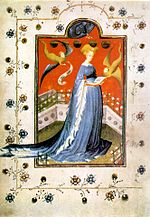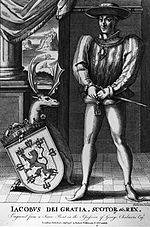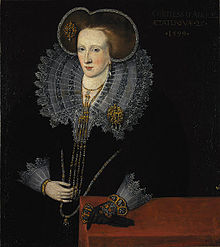- Princess Margaret Stewart of Scotland
-
- See also Margaret Stewart.
Margaret Stewart Issue Margaret Crichton
Sir James Crichton?House House of Stewart Father James II of Scotland Mother Mary of Guelders Margaret Stewart, Princess of Scotland (c. 1455 – ?) was a Scottish princess of the House of Stewart. She was the younger daughter of King James II and Queen Mary of Guelders, a Dutch princess by birth. Once engaged to the Lancastrian Prince of Wales, Margaret instead became the mistress of William Crichton, 3rd Lord Crichton (an enemy of her brother, James III), and the mother of his illegitimate daughter, Margaret Crichton, later Countess of Rothes, and possibly his son, Sir James Crichton, progenitor of the Viscounts of Frendraught.[1] Princess Margaret and Lord Crichton may have been married later, after the death of Crichton's wife.
Contents
Family
 Her mother, Mary of Guelders
Her mother, Mary of Guelders
 Her father, James II
Her father, James II
Princess Margaret was born between 1453 and 1460[2][3] in Scotland, the daughter of King James II of Scotland and Mary of Guelders. Her father's nickname was "Fiery Face" because of a conspicuous vermilion birthmark on his face (possibly a "port-wine stain"). She had four brothers including James, who would succeed to the Scottish throne as James III in 1460 upon their father's accidental death by an exploding cannon. She had an elder sister, Princess Mary Stewart, who married twice; firstly to Thomas Boyd, 1st Earl of Arran; secondly to James Hamilton, 1st Lord Hamilton. Margaret's mother died in 1463, leaving her an orphan at probably less than ten years old.
Her paternal grandparents were King James I of Scotland and Lady Joan Beaufort. Her maternal grandparents were Arnold, Duke of Guelders and Catherine of Cleves, daughter of Adolph IV, Duke of Cleves and Marie of Burgundy.
Marriage proposals
During the Wars of the Roses, Princess Margaret was briefly engaged to Edward of Westminster, Prince of Wales, the only son of Henry VI of England and Margaret of Anjou. However, the engagement was called off by her mother due to political pressure from King Edward IV of England and Duke Philip of Burgundy[disambiguation needed
 ]. In 1476, she was proposed by James III to George Plantagenet, 1st Duke of Clarence, and she was afterward to have been married to Anthony Woodville, 2nd Earl Rivers, brother-in-law of Edward IV; but neither of these alliances took place.[4]
]. In 1476, she was proposed by James III to George Plantagenet, 1st Duke of Clarence, and she was afterward to have been married to Anthony Woodville, 2nd Earl Rivers, brother-in-law of Edward IV; but neither of these alliances took place.[4]Later life
William Crichton, 3rd Lord Crichton of Auchingoul (grandson of Lord Chancellor Crichton) is said to have "deliberately debauched Margaret" (James III's youngest and favourite sister), after discovering that his wife had been seduced by the king.[5] Regardless of the truth of this story, Margaret did become Lord Crichton's mistress, which led to her disgrace and reputation for immorality and corruption. Their illegitimate daughter, also named Margaret, was born between 1478 and 1485 and raised in the royal court.[6] Princess Margaret may have had a son also, James Crichton, who married Catherine Borthwick, the eldest daughter of William, Lord Borthwick; however, James might have been the son of Lord Crichton's wife.
Lord Crichton joined Margaret's brother Alexander Stewart, Duke of Albany in his rebellion against Margaret's eldest brother, the unpopular King James III. On behalf of the duke, Lord Crichton garrisoned his "very ancient and magnificent" castle of Crichton, for which his lands and titles were forfeited by the Parliament of Scotland in 1484, when Albany was sentenced for treason.[1] His castle was granted to a minion of James III, Sir John Ramsay of Balmain.
According to historian George Buchanan (who was "always hostile"[7] to the Stewarts), Margaret had an incestuous relationship with her brother the king. Contemporary writers were unsympathetic in their descriptions of the princess. One writer calls her "a person, although young and beautiful, of depraved character, being even charged with too much familiarity with her own brother."[4] Another writer agrees, conceding that Margaret was "a Princess of great beauty, but of a reputation that was more than loose."[5]
Sir Walter Scott writes:
- [After garrisoning his castle and fleeing to England,] William, the hereditary Lord of Crichton, pined in exile, from which he is said to have been recalled under the following circumstances: The Lady of Crichton, says Buchanan, died soon after her husband's flight to England; and the king, desirous to hide the disgrace of his favourite sister, who was almost frantic for the loss of her paramour, recalled Crichton from banishment, on condition of his marrying the Princess Margaret. They were wedded accordingly, and Crichton seems to have obtained restitution of that part of his fortune which descended to him by his mother, the Barony of Frendraught, namely, in the North, which from this time became his residence, and that of his successors. Crichton was reconciled to the king, and admitted to his presence at Inverness, during an expedition which James made towards the North near the conclusion of his reign. He therefore entertained hopes of obtaining a full pardon, but neither of the brothers-in-law long survived the interview. Crichton died at Inverness, where, according to Buchanan, his monument was extant in the time of the historian. It seems uncertain whether the son who survived William Lord Crichton was the child of the Princess Margaret; but he left a daughter, their undoubted issue, who became Countess of Rothes.
If Scott's account is accurate, Princess Margaret, then Lady Crichton, may have spent the rest of her life at Crichton's residence "in the North", at the Barony of Frendraught.
Descendants
Princess Margaret's daughter, Margaret Crichton, possibly had four daughters by her third husband, George Leslie, 4th Earl of Rothes, Ambassador to Denmark (whom she married twice), including Agnes Leslie, Countess of Morton, and two sons, William Rothes and Norman Leslie, Master of Rothes whose rights of inheritance were forfeited as a result of both having been implicated in the murder of Cardinal Beaton in 1546. Their father, the 4th Earl of Rothes, was tried and acquitted of the same crime. However, the mother of these children might have been a different wife of Rothes.
Princess Margaret's possible granddaughter Lady Margaret Leslie married Archibald Douglas, 8th Earl of Angus in 1575 and divorced him in 1587, probably because of her "infertility". (He remarried two weeks later.)[8] Another granddaughter, Lady Helen Leslie, had several children with Mark Kerr, the abbot of Newbattle, including Mark Kerr, 1st Earl of Lothian.[9]
Among her numerous possible descendants are included Diana, Princess of Wales and Camilla Parker-Bowles.
Ancestors
Ancestors of Princess Margaret Stewart of Scotland 16. Robert II of Scotland 8. Robert III of Scotland 17. Elizabeth Mure 4. James I of Scotland 18. John Drummond of Lennox 9. Anabella Drummond 19. Mary Montifex 2. James II of Scotland 20. John of Gaunt 10. John Beaufort, 1st Earl of Somerset 21. Katherine de Roet 5. Joan Beaufort 22. Thomas Holland of Kent 11. Margaret Holland 23. Alice FitzAlan 1. Princess Margaret of Scotland 24. Arnold I of Egmond 12. John II of Egmond 25. Jolanthe of Leiningen 6. Arnold, Duke of Gelderland 26. John XII of Arkel 13. Maria van Arkel 27. Joanna of Jülich 3. Mary of Guelders 28. Adolph III of Mark 14. Adolph I, Duke of Cleves 29. Margaret of Julich 7. Catherine of Cleves 30. John II of Burgundy 15. Mary of Burgundy 31. Margaret of Bavaria References
- ^ a b Burke, 145-146.
- ^ The Peerage gives her birth between the years 1449 and 1463, but 1453 and 1460 is probably closer. 1453 is the year of her sister Mary's birth, and Margaret was younger than Mary; 1460 is the year of her father's death.
- ^ http://thepeerage.com/p10534.htm#i105333
- ^ a b Riddell, 193.
- ^ a b Paul, 64.
- ^ Lang, 360.
- ^ Scott, 87
- ^ thePeerage.com Lady Margaret Leslie page
- ^ thePeerage.com Helen Leslie page
Sources
- Burke, Bernard (1866), A Genealogical History of the Dormant, Abeyant, Forfeited, and Extinct Peerages of the British Empire: Harrison.
- Lang, Andrew (1903), A History of Scotland from the Roman Occupation, Volume 1: Dodd, Mead and Co.
- Paul, James Balfour (1906), The Scots Peerage: Founded on Wood's Edition of Sir Robert Douglas's Peerage of Scotland; Containing an Historical and Genealogical Account of the Nobility of that Kingdom: D. Douglas.
- Riddell, John (1833), Remarks upon Scotch peerage law...: T. Clark.
- Scott, Walter. "Crichton Castle." Miscellaneous Prose Works of Sir Walter Scott. Vol. 2. Edinburgh: R. Cadell, 1834. 87-88. Google Books. Web. 2 May 2010.
- Alison Weir: Lancaster and York: War of the Roses, London (1995) ISBN 97-800-995-40-175
Categories:- 1450s births
- House of Stuart
- Scottish princesses
- Women of medieval Scotland
Wikimedia Foundation. 2010.

